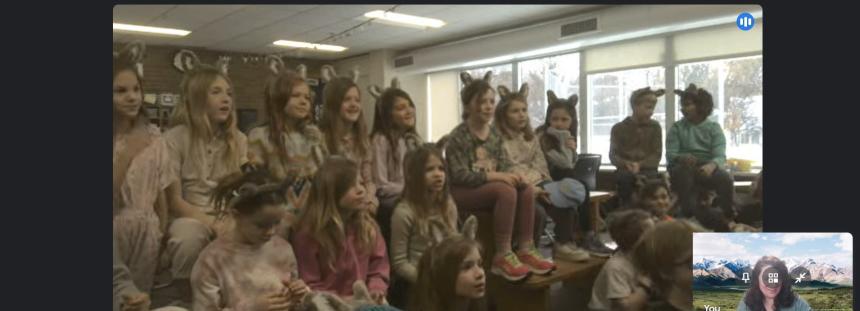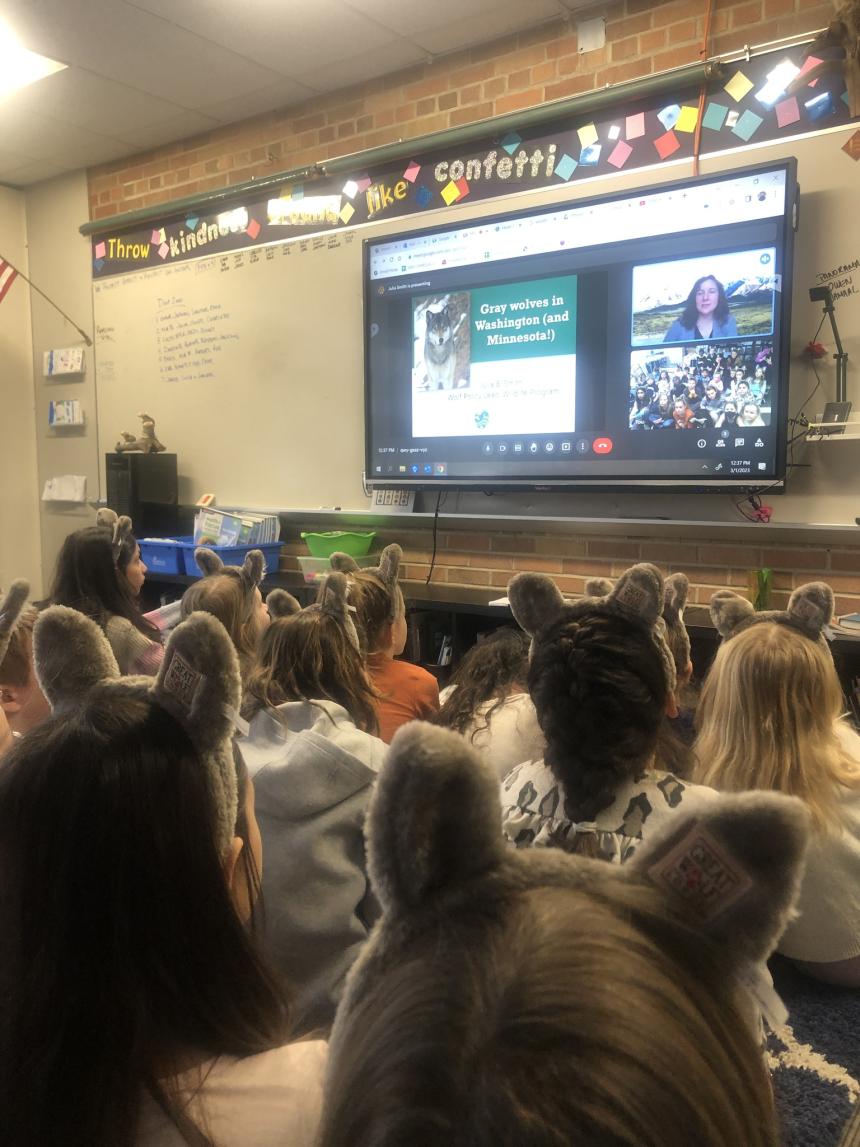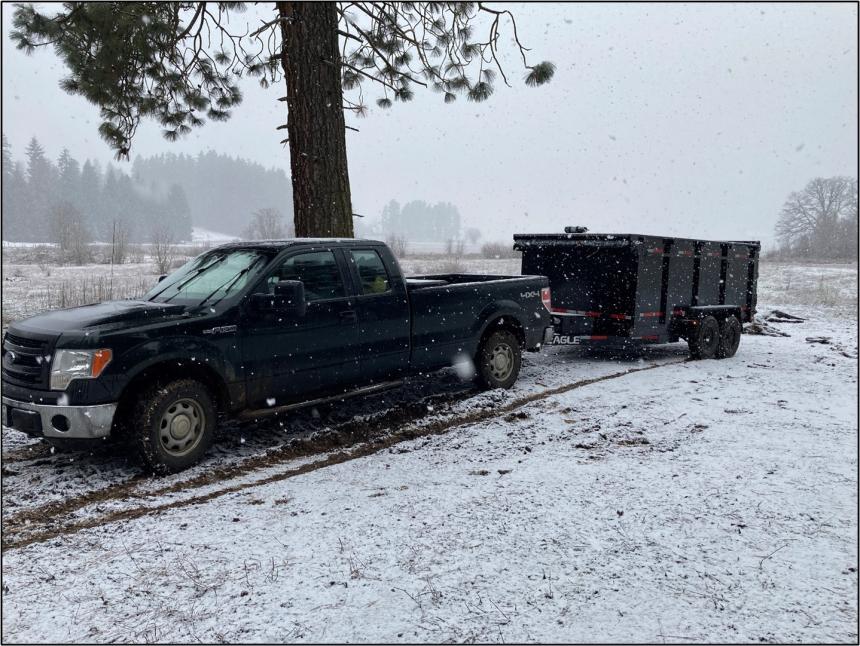This update provides an overview of gray wolf conservation and management activities in Washington during March 2023.
Program updates and coordination
- WDFW is currently accepting applications for contracted range riders for the 2023 season. Applications and contract updates can be found here: https://wdfw.wa.gov/species-habitats/at-risk/species-recovery/gray-wolf/updates/contracted-range-rider-rfq-2023-now-available
Questions about applying or need assistance with the application? Reach out to WildlifeConflict@dfw.wa.gov.
- WDFW received the final peer-reviewed report from the University of Washington (UW) detailing the Washington wolf population model and scenarios developed and presented to the Fish and Wildlife Commission last year by UW scientists. The report came in the form of two peer-reviewed manuscripts that are now publicly available on bioRxiv:
Petracca LS, B Gardner, BT Maletzke, and SJ Converse. 2023. Merging integrated population models and individual-based models to project population dynamics of recolonizing species. bioRxiv doi: 10.1101/2023.03.14.532675.
Available at: https://www.biorxiv.org/content/10.1101/2023.03.14.532675v1
Petracca LS, B Gardner, BT Maletzke, and SJ Converse. 2023. Forecasting dynamics of a recolonizing wolf population under different management strategies. bioRxiv doi: 10.1101/2023.03.23.534018.
Available at: https://www.biorxiv.org/content/10.1101/2023.03.23.534018v1
The information in these reports are part of what will inform WDFW’s upcoming Periodic Status Review for the Gray Wolf (PSR). The information in these reports was presented to the Fish and Wildlife Commission last year. On February 19, 2022, UW scientists briefed the Commission on the population model and potential conservation and management scenarios that will inform the PSR. The meeting recording is available here (presentation starts at approximately 1:03:00) and the associated presentation is available here (PDF).
The release of the DRAFT Periodic Status Review (PSR) for the Gray Wolf and start of the associated public comment period are tentatively scheduled for May 2023.
-
The North Cascades Institute is hosting an online program, “Wolves in Washington: Updates from WDFW and the Wolf Advisory Group,” on April 26, 2023 at 5:30 PM. In this follow-up to last year's popular program, biologists with the Washington Department of Fish & Wildlife will give an overview of the status of wolves in the state, provide updates on current wolf packs, and take questions too. We’ll also learn how to stay updated and get involved, as well as how the Washington Wolf Advisory Group is working to promote equitable, inclusive, and respectful dialogue and decision-making among diverse people. Their goal is to foster durable peace by transforming the root causes of social conflict and providing quality recommendations on wolf recovery, conservation, and management. REGISTER HERE!
- On March 18, WDFW staff, Department of Agriculture staff, and representatives from the Cattle Producers of Washington and Northeast Washington Wolf-Cattle Collaborative provided a briefing and had discussion with the Fish and Wildlife Commission on wolf management topics, as requested by the Commission. These topics included range riding coordination and funding, other non-lethal conflict mitigation tools, areas of chronic conflict, adaptive management, and conflicts/poaching in 2021. The recording of the session is available here (starts at approximately 1:30:00) and associated materials are available here (agenda items 12 and 12A).
- The Washington Department of Fish and Wildlife (WDFW) Police continue to investigate six wolf mortalities within the Wedge pack territory in Stevens County. WDFW Police began the investigation in February 2022, and it is ongoing. Toxicology results revealed all six wolves died from ingesting poison. The investigation remains active, and the Department encourages anyone who might have relevant information to report it confidentially by calling WDFW's poaching hotline, 877-933-9847, or by texting a tip to 847411. Rewards totaling $53,900 are available for information that leads to a conviction in the case of the poisoning of Stevens County wolves.
Outreach and education
WDFW’s Statewide Wolf Specialist gave a presentation to the Careers in Wildlife class at University of Montana.
WDFW’s Wolf Policy Lead gave a presentation on wolves for two elementary school classes and answered the students’ questions.



Current population status and proactive conflict mitigation
The year-end minimum population count for 2021 was at least 206 known wolves in 33 known packs including at least 19 breeding pairs. Annual wolf population surveys are conducted in the winter because wolf populations experience the least amount of natural fluctuation during this time. Counting the population at the end of each year allows for comparable year-to-year trends at a time of year when the wolf population is most stable. The year-end minimum population count for 2022 will be released in April 2023.
Reports of remote camera images or videos, wolf tracks, or sightings from the public are extremely helpful in locating previously undocumented wolf activity and potential new packs on the landscape. Please take photos of wolves or wolf sign (use some way to measure the size of a track) and upload them to the wolf reporting page via the following link: https://wdfw.wa.gov/species-habitats/at-risk/species-recovery/gray-wolf/observations
Definitions: A “pack” is defined as two or more wolves traveling together in winter, and a “breeding pair” is defined as at least one adult male and one adult female wolf that raised at least two pups that survived until December 31. In any given year, the number of packs will always be greater than or equal to the number of breeding pairs. The known territories and more information for each pack can be viewed by clicking the pack name.
Beaver Creek pack
Biologists spent several days surveying for tracks and checking cameras to document wolf activity in this pack territory.
Butte Creek pack
Biologists spent several days surveying for tracks and checking cameras to document wolf activity in this pack territory.
Carpenter Ridge pack
No activity to report.
Columbia pack
Biologists spent several days surveying for tracks and checking cameras to document wolf activity in this pack territory.
The local WDFW wildlife conflict specialist met with multiple livestock producers to discuss preparations for the grazing season. Discussions included herd size, pasture location, proactive non-lethal deterrents planned, and range rider plans.
Dirty Shirt pack
No activity to report.
Dominion pack
No activity to report.
Goodman Meadows pack
No activity to report.
Grouse Flats pack
Biologists spent several days surveying for tracks and checking cameras to document wolf activity in this pack territory.
Huckleberry pack
Biologists spent several days surveying for tracks and checking cameras to document wolf activity in this pack territory.
Leadpoint pack
No activity to report.
Lookout pack
Biologists spent several days surveying for tracks and checking cameras to document wolf activity in this pack territory.
Loup Loup pack
No activity to report.
Navarre pack
No activity to report.
Onion Creek pack
No activity to report.
Salmo pack
No activity to report.
Shady Pass pack
No activity to report.
Sherman pack
Biologists spent several days surveying for tracks and checking cameras to document wolf activity in this pack territory.
Skookum pack
No activity to report.
Smackout pack
No activity to report.
Stranger pack
No activity to report.
Sullivan Creek pack
No activity to report.
Teanaway pack
At least one wolf has been captured on cameras southwest of the Teanaway pack territory but north of Interstate 90 this past month. Also, at least one wolf has been located in the adjacent and vacant Naneum territory.
Togo pack
No activity to report.
Touchet pack
Biologists surveyed for tracks and checked cameras to document wolf activity in this pack territory.
Tucannon pack
Biologists surveyed for tracks and checked cameras to document wolf activity in this pack territory. The collared wolf in this pack (WA139f) left the historical territory of the Tucannon pack in late January and over the course of several weeks moved southeast into northeastern Oregon. Wolves make “extra territorial movements” from time to time, especially in the winter breeding season or when dispersing, and a movement like this is not unusual. WDFW wildlife conflict specialists were in touch with affected livestock producers as the collared wolf moved around. Biologists learned that there were multiple other wolves with the collared wolf, likely other wolves from the Tucannon pack. These wolves spent most of the month of February in northeast Oregon, where they were involved in multiple depredations on cattle. One of the wolves in the group was lethally removed by an affected livestock producer in Oregon. Updates for wolves in Oregon can be found at https://dfw.state.or.us/wolves/updates.html.
In March, this group of wolves has spent time in both Wallowa County in Oregon and Asotin County in Washington. There have been no documented depredations on livestock by this group of wolves in Washington at the time of this writing.
WDFW wildlife conflict specialists continue to coordinate with livestock producers and community members in the area. WDFW wildlife conflict specialists had daily check-ins with the Asotin County Cattleman’s Association President and multiple livestock producers in the area of recent wolf activity. WDFW staff traveled to the Anatone area to check for signs of wolf activity and to collect information. A WDFW wildlife conflict specialist met with two producers in the area to discuss the recent activity and to deliver more Fox Lights (a proactive motion-sensing deterrent that flashes lights to give the impression of a human in the area with a flashlight) to one of them. Staff located tracks from four wolves and took sighting reports from members of the public.
During February and March, WDFW biologists documented continued wolf activity in the traditional Tucannon pack territory including wolves exhibiting courtship behavior, indicating this territory is still in use. Packs can fracture or split apart for multiple reasons, including breeder loss or replacement, group dispersal, and social dynamics within the pack. At this time, biologists do not know if the wolves in the WA139f group have formed a new pack, if the area where they are now is where they will stay, if and where they will den, or whether they will return to the historic Tucannon pack territory. Staff will continue to monitor them.
Vulcan pack
No activity to report.
Wedge pack
No activity to report.
Miscellaneous/lone wolves
Biologist hiked 17 miles from Prince Creek to Stehekin to check trail cameras and search for wolf activity in that area.
Yakima/Klickitat County: WDFW staff continued to monitor a collared dispersing male wolf (originally from the Naneum pack) and an uncollared female wolf traveling in Yakima and Klickitat counties. Over the past month, WDFW Conflict Specialists began collecting and disposing of deceased livestock from livestock operations within the territory used by these two wolves in a proactive effort to prevent scavenging and potential wolf-livestock conflicts.

Note: The Frosty, Nason, Nc’icn, Keller Ridge, Strawberry, and Whitestone pack territories are within Confederated Tribes of the Colville Reservation (CTCR) lands and are managed under tribal authority. Information regarding these packs is proprietary and reported at the discretion of the CTCR.
Mortalities
There were no wolf mortalities documented in March. As of this update, WDFW has documented one wolf mortality in 2023.
Depredation activity
In 2022, 81% of known wolf packs were not involved in any documented livestock depredation.
WDFW did not document any wolf depredation events in March, slightly lower than the average (0.2) from 2018-2022.
Please report any suspected livestock depredations or the death or harassment of wolves to the WDFW Enforcement Hotline at 1-877-933-9847.
Below is a summary of packs with documented depredation activity within the past ten months (some packs have depredation history prior to the current ten-month window; this timeframe is considered based on guidance from the wolf-livestock interaction protocol (PDF)).
|
Pack |
Depredation date |
Depredation type |
Proactive non-lethals |
Ten-month window |
Agency lethal removal actions |
|
Grouse Flats |
8/12/22 |
Confirmed mortality of steer |
Yes |
6/12/23 |
|
|
|
8/30/22 |
Confirmed mortality of steer |
Yes |
6/30/23 |
|
|
Leadpoint |
8/22/22 |
Confirmed mortality of calf |
Yes |
6/22/23 |
|
|
|
9/1/22 |
Confirmed mortality of calf |
Yes |
7/1/23 |
|
|
|
9/16/22 |
Confirmed mortality of cow |
Yes |
7/16/23 |
|
|
|
9/19/22 |
Confirmed injury of calf |
Yes |
7/19/23 |
|
|
|
9/19/22 |
Confirmed injury of calf |
Yes |
7/19/23 |
Adult male removed 9/27/22; adult female removed 9/28/22 |
|
|
9/30/22 |
Confirmed injury of cow and calf (calf died from injuries) |
Yes |
7/30/23 |
|
|
|
10/7/22 |
Confirmed mortality of cow |
No |
8/7/23 |
|
|
Lookout |
5/20/22 |
Confirmed mortality of two lambs |
Yes |
3/20/23 |
|
|
Onion Creek |
2/1/23 |
Confirmed mortality of calf |
Yes |
12/1/23 |
|
|
Smackout |
8/17/22 |
Confirmed mortality of calf |
Yes |
6/17/23 |
|
|
|
8/20/22 |
Confirmed injury of calf |
Yes |
6/20/23 |
|
|
|
8/27/22 |
Probable injury of calf |
Yes |
6/27/23 |
|
|
|
8/28/22 |
Confirmed mortality of calf |
Yes |
6/28/23 |
|
|
|
8/31/22 |
Confirmed mortality of two calves |
Yes |
6/30/23 |
Juvenile male lethally removed 9/8/22 |
|
|
9/26/22 |
Probable mortality of calf |
Yes |
7/26/23 |
|
|
|
10/3/22 |
Confirmed injury of calf |
Yes |
8/3/23 |
|
|
|
10/6/22 |
Confirmed injury of calf |
Yes |
8/6/23 |
|
|
|
10/8/22 |
Confirmed injury of calf |
Yes |
8/8/23 |
Yearling female removed 10/10/22 |
|
|
10/12/22 |
Confirmed mortality of calf |
Yes |
8/12/23 |
|
|
Stranger |
7/28/22 |
Probable injury of calf |
No |
5/28/23 |
|
|
Togo |
5/17/22 |
Confirmed mortality of calf |
Yes |
3/17/23 |
|
|
|
5/18/22 |
Confirmed injury of calf |
Yes |
3/18/23 |
|
|
|
6/8/22 |
Confirmed mortality of calf |
Yes |
4/8/23 |
|
|
|
6/12/22 |
Confirmed injury of calf |
Yes |
4/11/23 |
Yearling female lethally removed 6/14/22; adult male lethally removed 6/17/22 |